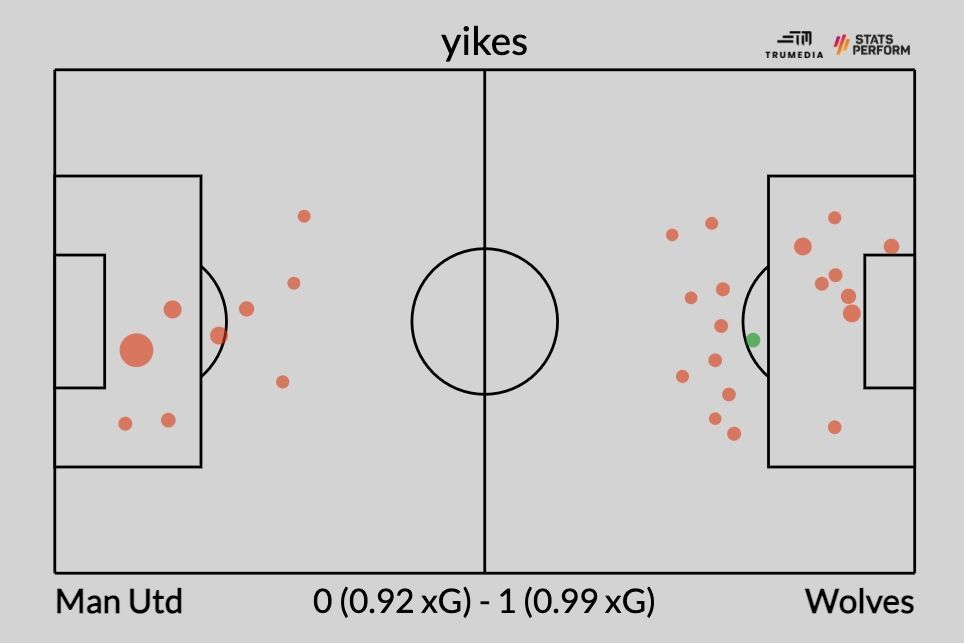Why Arsenal, Man United, Spurs, West Ham will, won’t do it
The Premier League’s title race might have ended on Sunday, but the top-four race is healthier than ever before. It didn’t stay up late on New Year’s Eve; no, it went to bed at 9 p.m., woke up at 5 a.m. the next day, went for a hike at 6, and by 7 a.m. was contemplating the year ahead — clear-headed and hangover free — from atop a quiet nearby peak. The year before, everyone thought they knew the top-four race; there was really only one word to describe it: predictable. But not anymore. With everyone else still asleep or groggy from the night before, the top-four race stated its intention for the first half of 2022: COMPLETE CHAOS.
Heading into the second half of the season, just four points separate seventh from fourth in the table. According to FiveThirtyEight’s projections, there are four teams (Arsenal at 38%, Tottenham at 31%, West Ham at 16%, Man United at 13%) who all have at least a 10% chance of finishing seventh, sixth, fifth and fourth. Unlike the title race, where every dropped point for Liverpool and Chelsea felt like an aberration and an ultimatum against the constant three-point churn of Manchester City, the teams in the race for the final Champions League qualification slot just simply aren’t as good. They drop points all the time! None of them average more than 1.8 points per match. There was even one stretch where Arsenal took nine points from six games … and actually moved up into fourth place. There’s plenty more of this to come, too:
Before we continue, a word for the teams on both sides of this cluster. Liverpool and Chelsea are both closer to fourth than to fifth right now, and per FiveThirtyEight, there’s a combined probability of 16% that one of them ends up in the fourth slot. But only a massive run of bad luck or suddenly awful form — or, frankly, both at the same time — would see either one dip any farther than that. Liverpool are 99% to finish top four, while Chelsea sit at 92%. As for Brighton, Leicester and Wolves, there’s a combined probability of 8% that one of them qualifies for the Champions League. Wake us up when one of you gets to 10%, would you?
So, let’s take a look at the four teams in the thick of the top-four race and the reasons they will — and why they won’t — be the ones sitting in fourth come late May.
Jump to: Arsenal | West Ham | Tottenham | Man United
 Arsenal (fourth place, 35 points from 20 games)
Arsenal (fourth place, 35 points from 20 games)
-
Points per game: 1.8
-
Goal differential per game: plus-0.4
-
Projected point total, per FiveThirtyEight: 65
-
Top-four odds, per FiveThirtyEight: 38%
Why they will finish top four: Gabriel Martinelli solves their problems
Take a look at the progression of Arsenal’s expected-goal differential through their first 19 matches:
They were in the red after getting pummeled by Brentford, Man City and Chelsea to start the season, then the schedule got a little easier and the performances improved a tiny bit, then Liverpool pushed them back down toward the bottom, and from there, it’s been a steady progression of improvement.
What happened? There’s no single explanation, but the simplest one is « Gabriel Martinelli started playing again. »
While Arsenal have the youngest team in the league (24.8 years) when you weight the age of the players by the minutes played, there’s one big question among their young attackers and even their older ones: Can anyone, uh, score goals?
Bukayo Saka is a fantastic dribbler and attacking outlet, but it’s unclear if he’ll ever be the kind of goal-scoring winger that populates all of Europe’s best teams. And while Martin Odegaard and Emile Smith-Rowe have scored goals (12 between them), they’ve done it on just 5.23 xG. That doesn’t bode particularly well for their likelihood of scoring goals in the future. As for the team’s two strikers, Pierre-Emerick Aubameyang might never play for Arsenal again and Alexandre Lacazette has attempted fewer shots than Nuno Tavares, the club’s back-up left-back.
Martinelli, though, has the profile of the kind of player that most modern teams are built around: an inverted attacker who presses like hell and gets on the ball in the box. Over the past calendar year, per the site FBref, the 20-year-old Brazilian ranks in the 94th percentile among wingers in non-penalty xG plus expected assists, and the 89th percentile for touches in the penalty area. He’s also above average in just about every quantifiable defensive metric. He doesn’t touch the ball much and does very little to move the ball up the field, but hey, that’s what Saka, Odegaard, and Smith-Rowe are for.
Why they won’t finish top four: They’re gonna start drawing games
Arsenal play in a way that seems almost designed to lead to even scorelines. They don’t move the ball quickly; only Brighton and Manchester City push the ball up field at a slower rate. They don’t press; their PPDA (Opposition Passes Allowed per Defensive Action) is below the league average, and only the two Manchester clubs feature fewer possessions in their matches.
For all of that to lead to something better than an average team, you’d need to either keep the ball away from your opponent, or be really efficient at creating high-quality opportunities from a limited number of lengthy possessions. But neither of those things is true of Arsenal. Mikel Arteta’s team averages less than 50% of possession, and 42% of their uninterrupted possessions reach the final third, which is only the eighth-best mark in the league.
A slow team that doesn’t win the ball high up the field and also isn’t super-effective at moving the ball up the field seems like they should play a bunch of grind-it-out stalemates. Despite that, Arsenal’s results have been some of the most volatile and unpredictable that you’ll ever see. They only have two draws through 19 games, while only eight of their matches have been decided by a single goal or fewer — the fewest in the league. But unless something changes in the way that they play, Arsenal are going to draw more matches over the second half of the season. Will that lead to more wins or more losses?
 West Ham United (fifth place, 34 points from 20 games)
West Ham United (fifth place, 34 points from 20 games)
Why they will: They’re the most consistent team in the race
Anything can happen when Arsenal play a match, while both Manchester United and Tottenham are already on their second managers of the season. West Ham, meanwhile, look the same in every game. David Moyes has been on the sideline for two years now, and we all know what to expect: Declan Rice and Thomas Soucek sit in front of the back four, and some combination of Jarrod Bowen, Said Benrahma, Pablo Fornals, and Manuel Lanzini spring the counterattacks that get finished off by Michael Antonio and somehow, sometimes, Soucek.
They’re not gonna keep the ball, they’re not gonna press and they’re gonna break forward at speed. It’s not the most complex method of play, but it works because of a bunch of good players with complementary skill sets who know how to play together.
They’re averaging 1.7 points per game this season — the same exact pace they ran at for the entirety of last year. In 2020-21, they missed out on fourth by two points, and it was nearly enough to overtake the team that won the European Cup. None of their competitors for fourth place this season are as good as Chelsea were last year.
A couple more points in favor of the Hammers: They have the best goal differential among these four, and they’ve been better against the best. In games against Manchester City, Liverpool, and Chelsea, they’ve already won six points, while Man United, Arsenal and Spurs have combined for just five points from their 11 matches against the top three. That could help them in two ways: They’ve already banked a bunch of unlikely points that their closest competitors might never get, and they also might be more likely than any of their closest competitors to take more of those points in the future.
Why they won’t: They’ve stayed healthy — and they haven’t built up a lead
The biggest question about West Ham at the start of the season was: Do they have enough depth? They’d qualified for the Europa League, so they’d be playing more matches and traveling across the continent. Could they rotate the minutes around enough without watering down their ability to challenge in both competitions? And would they be able to handle the increased likelihood of injury that comes from an increased number of matches?
In particular, there were two areas of concern: the midfield and up front. Last season, Soucek played literally every minute of the Premier League season, while Rice was on the field for 84% of them. Next man up was now-34-year-old Mark Noble, and although West Ham finished last season with a plus-15 goal differential and he only played 712 minutes, they were minus-4 when Noble was on the field. Then there’s Antonio, who’s simply been one of the best strikers in the Premier League for the past two years — when he’s been on the field. He only played 58% of the minutes last season, and with Sebastien Haller off lighting up the Champions League for Ajax and no real backup to replace him, it seemed like anything less than that might doom the Hammers.
Well, Soucek has played 99% of the minutes, Rice has increased his share up to 95%, and Antonio has been out there 92% of the time. Despite the ever-presence of their least replaceable players, West Ham haven’t been able to win points at a higher clip than last season — much of which was spent without Antonio and occasionally Rice. On top of that, their xG differential has declined slightly from last season, too. The injuries to center backs Angelo Ogbonna and Kurt Zouma haven’t helped. But while Zouma is set to return soon, it seems unlikely that Soucek, Rice and Antonio remain on the field for as long as they have over the first 20 matches.
 Tottenham (sixth place, 33 points from 18 games)
Tottenham (sixth place, 33 points from 18 games)
0:54
Nedum Onuoha is impressed with Tottenham’s ability to find a way to win in their 1-0 win over Watford.
Why they will: Antonio Conte
See if you can figure out when Spurs hired one of the best managers in the world:
Since Conte arrived in London, here’s where Tottenham rank across a number of key metrics:
And here’s where they were before Conte came to town:
Before Conte, they were a below-average team. After Conte, they’ve been one of the three best teams in England. The wildest part about it is that Conte hasn’t even made any real massive personnel changes.
There’s an adage called the « new manager bounce, » which is just when a team that was getting unlucky fires its coach and the new guy benefits from some regression to the mean. Then there’s the « he’s just playing his best players » bounce, when the new guy makes some simple personnel changes that immediately improve the underlying performance of the team. And then there’s what Conte’s done so far: immediately make a similar collection of players way better than they were before.
Why they won’t: They’re not this good
Tottenham’s recent improvement feels like it’s stickier than Arsenal’s. While the Gunners just sort of suddenly started to play better over the past two months, Conte has a long history of quickly making his teams a lot better than they were before. That’s pretty much what’s happened with Spurs, except this is a bigger and faster improvement than ever before. Are Spurs really as good as Chelsea now that Antonio Conte is their coach? That’s hard to believe — for now.
Part of the reason Tottenham’s performances seem super-charged is the schedule. Yes, they played Liverpool, but the Reds were without Virgil van Dijk and their entire starting midfield of Fabinho, Jordan Henderson and Thiago. In the other seven matches, none of their opponents were even in the top half of the league table.
Tottenham are better than they have been at any point since Mauricio Pochettino left the club, but how much better? With Arsenal, Chelsea and City coming up over their next five Premier League matches, we’ll know soon enough.
 Manchester United (seventh place, 31 points from 19 games)
Manchester United (seventh place, 31 points from 19 games)
Why they will: They have great players … right?
According to the crowdsourced valuations at Transfermarkt, Manchester United have the fourth-most valuable squad in the world. Only three other clubs (Man City, Paris Saint-Germain and Chelsea) have more theoretical value on their books. It’s not a direct proxy for how good your team is or how much talent you have, but the point is that Manchester United have one of the most talented teams in the world. Even if the Transfermarkt values aren’t accurate, let’s be conservative and say that when you count up all their players individually it adds up to one of the 10 best.
1:21
Don Hutchison reacts to Wolverhampton Wanderers’ first win over Manchester United at Old Trafford since 1980.
Just take it from back to front: David De Gea is arguably the best keeper of his generation. Raphael Varane is one of the best center-backs of his generation. Harry Maguire has been one of the best center-backs in the Premier League for nearly half a decade now. Last year, Luke Shaw looked like one of the best left-backs in the world. Paul Pogba might not have ever lived up to his transfer fee, but that doesn’t mean he isn’t a fantastic soccer player.
Bruno Fernandes has been arguably the best creator in the Premier League since he came over from Sporting Lisbon in 2019. Jadon Sancho was a superstar in the Bundesliga for Borussia Dortmund. Marcus Rashford and Anthony Martial have already led the way for attacks on teams that finished top four. Edinson Cavani is one of the most underrated « winners » — he does all the little things that help his team win — of the modern era. And Cristiano Ronaldo, well, you get the point.
Plus, thanks to a teamwide COVID-19 shutdown that led the club to close its training ground, Ralf Rangnick just hasn’t had much time to work with the team and almost no time to work with the full team. United don’t play in the Premier League for two weeks now; he finally has some time to figure out how to get all that talent to click.
Why they won’t: They’ve been a bad team for a full half-season
They’ve played 19 games, and they have a NEGATIVE xG differential.
Now, some things have improved under Rangnick. Their per-game xG differential is plus-0.38 under the German, and it was minus-0.28 under Ole Gunnar Solskjaer. They’re winning the ball back higher up the field, and they’re completing a much higher share of the final-third passes in their matches. They’re playing much longer passes and much more direct passes in buildup play, and their games feature more possessions than they did under OGS, which means more of the transition moments that Rangnick believes are the key to winning matches.
At the same time, the schedule has been as easy as can be: the three worst teams in the league (Norwich, Newcastle, Burnley) plus home matches against Crystal Palace and Wolverhampton. Three wins, one draw and one loss from those games feels like the bare minimum, and there hasn’t really been a trajectory of improvement. Monday’s loss to Wolverhampton — getting outshot 19 to 7 at home by one of the least potent attacking teams in the league — was their worst game yet under Rangnick.
It still feels like it should be better than this, but with each passing game, we’re getting closer and closer to an uncomfortable truth: This expensive collection of talent might just not ever work together, no matter who’s coaching the team.


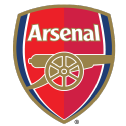 Arsenal (fourth place, 35 points from 20 games)
Arsenal (fourth place, 35 points from 20 games)
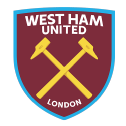 West Ham United (fifth place, 34 points from 20 games)
West Ham United (fifth place, 34 points from 20 games) Tottenham (sixth place, 33 points from 18 games)
Tottenham (sixth place, 33 points from 18 games)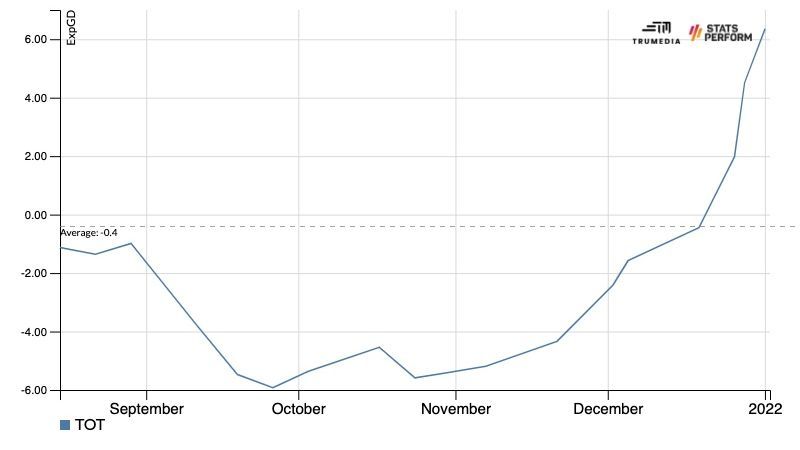
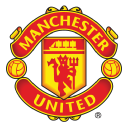 Manchester United (seventh place, 31 points from 19 games)
Manchester United (seventh place, 31 points from 19 games)
